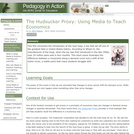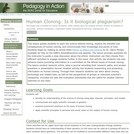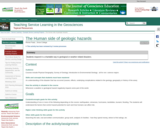
Students of paleontology, evolutionary biology and Earth history will be best able to critically analyze readings about evolution if they have first hand experience generating their own evolutionary hypotheses. In this lab exercise, students apply the principles of cladistics to create evolutionary trees of fun, familiar objects. The candy bar lab concept -- expanded here - came from Dr. Robert Gaines of Pomona College.
Part A -- Candy bars: The instructor provides about 12 "taxa" of candy bar. Students are welcome to taste the samples as they work, but make sure some of each bar is left for examination. Working in groups, students assign characters and states to the candy taxa, decide what's synapomorphic, and sketch a cladogram (tree), marking where new characters or states arise. Toward the end of the period, groups share their findings with the rest of the class, and together all students decide on the best tree. As students discuss the validity of their characters and argue about how to arrive at the most parsimonious tree, they will begin to comprehend the rules -- and pitfalls -- of cladistic analysis. At this point, the instructor might have them actually enter character data into a computer program such as MacClade, and project the tree results for all to see and discuss.
Part B -- Get creative!: After the candy bar lab, the students' homework assignment is to construct a cladogram and evolutionary hypothesis about a group of objects of their choosing. Ideas for "taxa" include models of car (characters could include hatchback, 4WD, sunroof, number of seats, engine capacity, etc.), board games (spinner or dice, number of players, cards used, etc.), or rock bands (members, instruments, genre, etc.). Just about anything -- biological organisms excluded -- with enough characters and states can be used, and students enjoy coming up with unique approaches. Students will hand in a character matrix, hand-drawn tree with character transformations indicated, and an evolutionary narrative explaining the relationships among their group and discussing constraints and biases. Depending on the time allotted, and the instructor's expertise, this could go a step further with students entering character data into PAUP and/or MacClade to obtain computer-generated trees.
(Note: this resource was added to OER Commons as part of a batch upload of over 2,200 records. If you notice an issue with the quality of the metadata, please let us know by using the 'report' button and we will flag it for consideration.)
- Subject:
- Biology
- Life Science
- Material Type:
- Activity/Lab
- Provider:
- Science Education Resource Center (SERC) at Carleton College
- Provider Set:
- Teach the Earth
- Author:
- Hilary Lackey
- Date Added:
- 08/19/2019



















